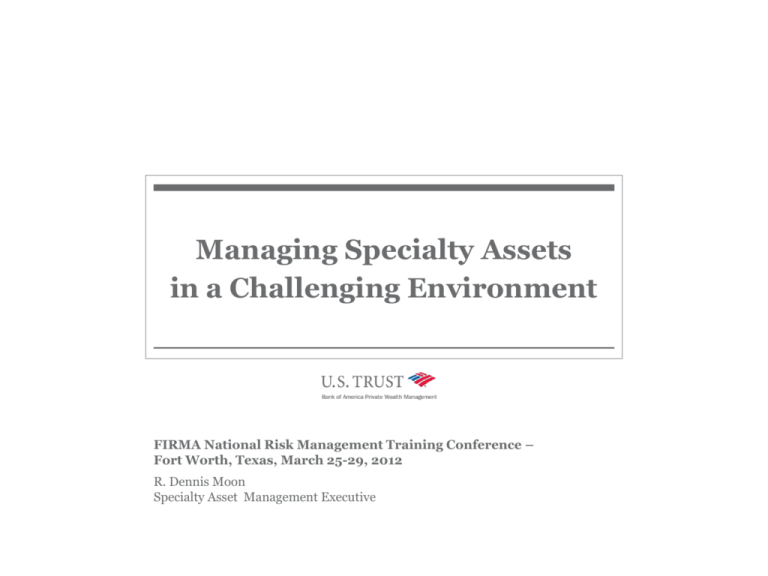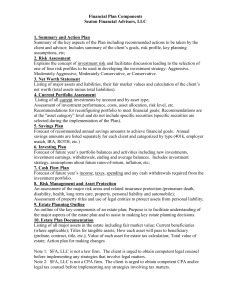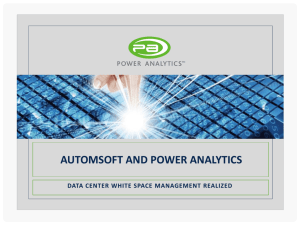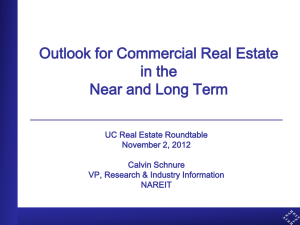
Managing Specialty Assets
in a Challenging Environment
FIRMA National Risk Management Training Conference –
Fort Worth, Texas, March 25-29, 2012
R. Dennis Moon
Specialty Asset Management Executive
DISCLOSURE
This presentation is designed to introduce you to the products and services available through U.S. Trust, Bank of America Private Wealth Management, is provided for informational purposes only, and is not issued in
connection with any proposed offering of securities. This presentation is not used with regard to any specific investment objectives, financial situation or particular needs of any specific recipient and does not contain
investment recommendations. Bank of America and its affiliates do not accept any liability for any direct, indirect or consequential damages or losses arising from any use of this presentation or its contents. The
information in this presentation was obtained from sources believed to be accurate, but we do not guarantee that it is accurate or complete. The opinions expressed herein are made as of the date of this material and
are subject to change without notice. There is no guarantee the views and opinions expressed in this presentation will come to pass. Other affiliates may have opinions that are different from and/or inconsistent with
the opinions expressed herein and may have banking, lending and/or other commercial relationships with Bank of America and/or its affiliates.
IMPORTANT: The material presented is designed to provide general information about ideas and strategies. It is for discussion purposes since the availability and effectiveness of any strategy is dependent upon
your individual facts and circumstances. Always consult with your independent attorney, tax advisor, investment manager, and insurance agent for final recommendations and before changing or implementing any
financial, tax, or estate planning strategy.
Investment products:
Are Not FDIC Insured
Are Not Bank Guaranteed
May Lose Value
U.S. Trust, Bank of America Private Wealth Management operates through Bank of America, N.A. and other subsidiaries of Bank of America Corporation.
Bank of America, N.A., Member FDIC.
Nonfinancial assets, such as closely-held businesses, real estate, oil, gas and mineral properties, and timber, farm and ranch land, are complex in nature and
involve risks including total loss of value. Special risk considerations include natural events (for example, earthquakes or fires), complex tax considerations, and
lack of liquidity. Nonfinancial assets are not suitable for all investors.
Investing in securities involves risks, and there is always the potential of losing money when you invest in securities.
This presentation may not be reproduced or distributed by any person for any purpose without prior written consent.
© 2011 Bank of America Corporation. All rights reserved. AR52A0K6
FOR FIDUCIARY USE ONLY
ECONOMIC OVERVIEW
Recession
They define a recession as the time when business activity
has reached its peak and starts to fall until the time when
business activity bottoms out. When the business activity
starts to rise again it is called an expansionary period. By
this definition, the average recession lasts about a year.
Factors in employment, industrial production, real income
and wholesale-retail sales.
Depression
A recession that lasts longer and has a larger decline in business activity.
“Source: Business Cycle Dating Committee at the National Bureau of Economic Research (NBER)”
Common Definitions
Recession – When you neighbor loses his job
Depression – When you lose your job
Leading Indicators
•
•
•
•
•
•
•
Stock Market
Manufacturing Activity
Inventory Levels
Retail Sales
Building Permits
Housing Market
Level of New Business Start-ups
Lagging Indicators
•
•
•
•
•
•
•
•
•
Changes in Gross Domestic Product
Income & Wages
Unemployment Rate
Consumer Price Index
Currency Strength
Interest Rates
Corporate Profits
Balance of Trade
Value of Commodity Substitutes to US
Dollar
Market Currents Illustrated
March 2012
New orders sag; unfilled orders cushion; expectations up
Consumer demand advancing around a 2% yr/yr growth path
10
60
Real Consumer Spending Growth
Year-to-Year % Change
6-Month % Change, Annualized
Net %
Capital Goods Prospects
60
Real Retail Sales**
40
5
40
Core Unfilled Orders + Nondefense Aircraft Orders
L.S.
Capital Expenditures
Expectations Next 6 Months*
R.S.
20
Total Real Consumer
Spending*
January
20
0
0
-5
-20
-10
* Spending on durables, nondurables, services
** Retail sales & food services deflated by
Consumer Price Index for Goods/Commodities
05
06
07
Core Unfilled Orders**
L.S.
-20
*Average of Diffusion Indexes from Empire State, Kansas City, Philadelphia, Richmond Fed Surveys
**Manufacturers' Capital Goods Orders Excluding Defense & Aircraft
08
09
10
Data as of 3/1/2012
11
-40
12
-40
06
07
08
09
10
11
Data as of 2/28/2012
Source BEA/Haver Analytics
U.S. regional surveys: rebound holding
75
0
Core New Orders**
L.S.
12
13
Source: FRB,Census Bureau/Haver Analytics
U.S. leading Index: positively inclined
> 0 = Expanding, Net %
20
U.S. Composite Index of 10 Leading Indicators
U.S. Bottom-Up Current & Leading Indicators
15
Average of 5 Regional Diffusion Indexes:*
Expectations for Business Activity
in 6-Months
50
10
5
0
25
-5
Year/Year % Change
-10
0
6-Month Annualized % Change
-15
Average of 5 Regional Diffusion Indexes
of Current Economic Activity
-20
-25
-25
-50
*FRB District Surveys: Future Business Conditions (NY,Philadelphia,Kansas City, Texas Surveys);
Future Shipments (Richmond Survey)
00
01
Data as of 2/28/2012
02
03
04
05
06
07
08
09
10
11
-30
12
Sources: Federal Reserve Board/Haver Analytics
81
84
Data as of 2/17/2012
87
90
93
96
99
02
05
08
11
Sources: Conference Board/Haver Analytics
Market Currents Illustrated
March 2012
Housing foundations hardening
Multifamily market tighter in Q1 but way off mid-2011 high
175
800
Housing Market (January 2001 = 100)
Thousands of Units, SAAR
Above 50 = Tighter
Multi-Family Housing Indicators
(Quarterly Averages)
150
Affordability
100
Apartment Market Tightness Index
R.S.
600
75
400
50
125
Pending Home Sales
(1-Month Lead)
100
ALL
Home Sales
75
Permits, L.S.
Mortgage Purchase
Applications
50
January
200
25
0
05
06
07
08
Data as of 2/29/2012
Starts, L.S.
Single Family Home
Building Permits
Homebuilders':Traffic of Prospective Buyers
Single-Family Homes, (All Good = 100)
25
0
09
10
11
12
03
04
05
06
07
08
09
10
11
12
13
Source: National Multi Housing Council, Bureau of the Census/Haver Analytics
Data as of 2/16/2012
Sources: Census, NAR, NAHB, MBA/Haver Analytics
Positive trends for a commercial real estate recovery
Home prices: big declines behind us; stabilization not over
75
130
FHFA Purchase-Only House Price Index, SA
0
02
13
50+ = Increase
Units
Commercial Real Estate Indicators (Quarterly Data)
Home Prices
30000
2004= 100
120
CoreLogic
National House Price Index, SA
Excluding & Including Distressed
Properties
110
January
50
20000
Architectural Billings Index:
Commercial/Industrial Sector
L. S.
100
25
Median Price*
New Single-Family Homes
90
10000
All Existing-Homes
Median Prices*
S&P/Case Shiller Composite 20 Home Price Index,SA
80
Business Bankruptcy Filings*
R. S.
*Filings surged in anticipation of the October 17, 2005 implementation
of the Bankruptcy Abuse Prevention and Consumer Protection Act.
*Based on 12-Month Moving Average of Nonseasonally Adjusted Prices
05
06
Data as of 2/28/2012
07
08
09
10
0
11
12
13
Source: Census, CoreLogic, NAHB, S&P, Federal Housing Finance Agency/Haver Analytics
0
96
97
98
Data as of 2/22/2012
99
00
01
02
03
04
05
06
07
08
09
10
11
12
13
Sources: American Institute of Architects, Administrative Office of U.S. Courts/HaverAnalytics
GENERAL APPROACH TO MANAGING
SPECIALTY ASSETS – Timberland, Commercial &
Residential Real Estate, Oil & Gas, Farm & Ranchlands, Closely
Held Business Assets
Fully understand your role on all assets (custodian, agent, trustee, co-trustee,
etc)
• Understand the difference between asset management & fiduciary asset management
Develop an approach or asset monitoring & stick with it, with one caveat
• Continually review the process in light of specific risks. This includes frequency, depth, and valuation
issues
Provide to the Portfolio Manager what they need to know to fully understand
return (income, appreciation, & cash flow) & market risk (valuation volatility &
degree of illiquidity)
Fully integrate & document into an Investment Policy Statement (IPS)
Indentify concentrations and have controls in place to mitigate, when
applicable
Develop strong process & status reporting around reviews & critical processes
(inspections, valuations, appraisals, tax, insurance, etc)
TIMBERLAND
Review operating budgets to identify ways to conserve resources
• Do not skimp on inspections, taxes due, and risk mitigating expenses
In fact, on some tracts, increase frequency of physical inspections
Be alert for buying opportunities with respect to properties that may have
experienced temporary price drops due to local market impacts
Prepare for opportunistic timber sales
• Exploit spot market spikes
• Identify general market recovery early in order to quickly exploit spot market spikes or general
market recovery before pent up supply results in readjustment of markets as supply and demand
cycle back to equilibrium
COMMERCIAL & RESIDENTIAL
REAL ESTATE
General Asset/Property Management
• Review tax assessment values and appropriately protest
• Consider repairs and even elective renovations during this time while construction and
contractor prices may be temporarily reduced
• Manage expectations – client & account
Tenant Issues
• Work-outs and Modifications – Review each situation individually
• Delinquency issues
• Defaults and bankruptcies
• Identify alternative uses / redevelopment opportunities
Selling Property
• Deteriorating market: Price property to reflect market and other properties on the market. Be
prepared to market aggressively and adjust price as needed
• Stable/Flat Market: Correctly price and market property given timely market inputs
• Assess the quality of potential buyers
Purchasing Investment Property
• Recognize buying opportunities exist because of depressed price.
• Understand the economic engines to determine proper type of property to buy; location/market;
other specifics
OIL & GAS
Separate the notions of commodities versus oil & gas development
• Oil & gas commodity prices are heavily affected by the business cycle
• Cash flow fluctuations stem from both rate & volume volatility
• Oil & gas development is increasingly driven by rapid technological changes
Know what you own and where you are
• Areas that have long been dormant are springing to life
• There is often one opportunity to get the lease right – use an expert
• Experts must be versed in not the only oil & gas issues but, the fiduciary business as well
Understand your lease and stay on top of information
• Periodically review the lease
• Capture key data on each producing interest to monitor oil companies & paying agents
FARM & RANCH
Agricultural products volatility
• Exhibits less volatility due to business cycle fluctuations
• Exhibits more volatility due to natural/meteorological issues
Asset prices and returns are affected by several issues
• Federal agriculture policies
• Supply & demand for farmland & ranchland
• Whether the property is operated, crop share or cash rent
o Drives exposure to commodity price volatility
o Low commodity prices may induce tenants to cut corners or impair the ability to
pay the rent
Long-term value is driven by a combination of
• Limiting the impact of weather related calamities
• Ensuring the tenants & operators maintain the property
• Ensuring proper lease terms related to land stewardship
• Experienced farm managers, on the property, long-term view
CLOSELY HELD ASSETS
Probably the most sensitive asset class in an economic decline
• Operating companies will ultimately mimic the economic cycle
• Real estate holding companies will follow their properties
• Investment holding companies will follow the markets
Returns & fluctuations will track with the nature of the company but on a
lagged basis
Small operating companies often lack the cash reserves of larger, public
companies
Adjust to approach to asset management
• Collect financial statement more frequently & ask for complimentary information
• Review assets in a consistent manner (trend analysis, economic sensitivity, etc.)
• Adjust the robustness of the asset review relative to risk
• Adjust statement values early & often
• Optimize the balance of methodological consistency & applicability
• Ensure strong rigor around pre-acceptance & transaction approvals
Capital Market Outlook
March 5, 2012
America No Longer Drives Global Import Demand.
Drives Global Import Demand.
Longer
Exhibit
(%1:ofAmerica
World No
Total
Imports)
(% of World Total Imports)
The Baton of Consumption Has Shifted to the “Rest."
Exhibit
2: The BatonNations’
of Consumption
Shifted
to the
“Rest"
(Developing
% of Has
World
Total
Imports)
(Developing Nations % of World Total Imports)
20%
50%
19%
45%
18%
17%
16%
40%
Historic Average
35%
15%
14%
30%
13%
12%
25%
11%
20%
10%
48 51 54 57 60 63 66 69 72 75 78 81 84 87 90 93 96 99 02 05 08 11
Source:
International
Monetary
Fund Direction
of Trade Statistics.
of Trade Statistics.
Fund Direction
Monetary
International
Source:
Data
through
September
2011
Data through September 2011.
80 82 84 86 88 90 92 94 96 98 00 02 04 06 08 10
Source:
International
MonetaryMonetary
Fund Direction
Trade Statistics.
Source:
International
FundofDirection
of Trade Statistics.
Data
through
September
2011.
Data through September 2011












